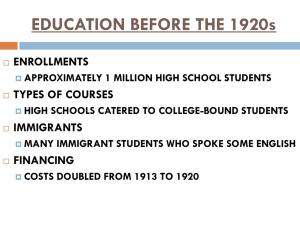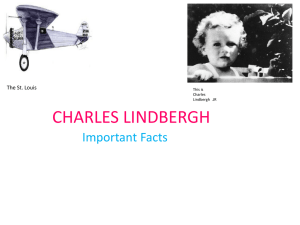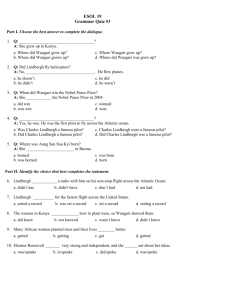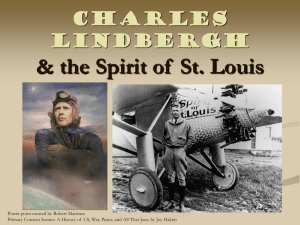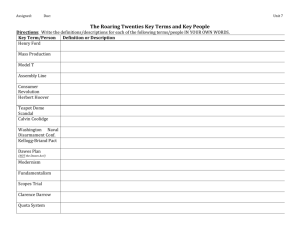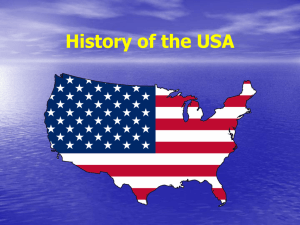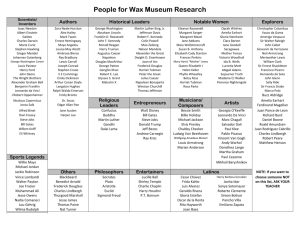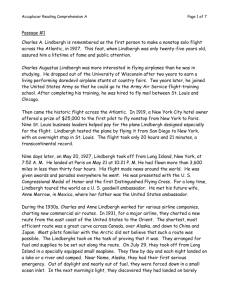document 1 - Charles Lindbergh
advertisement
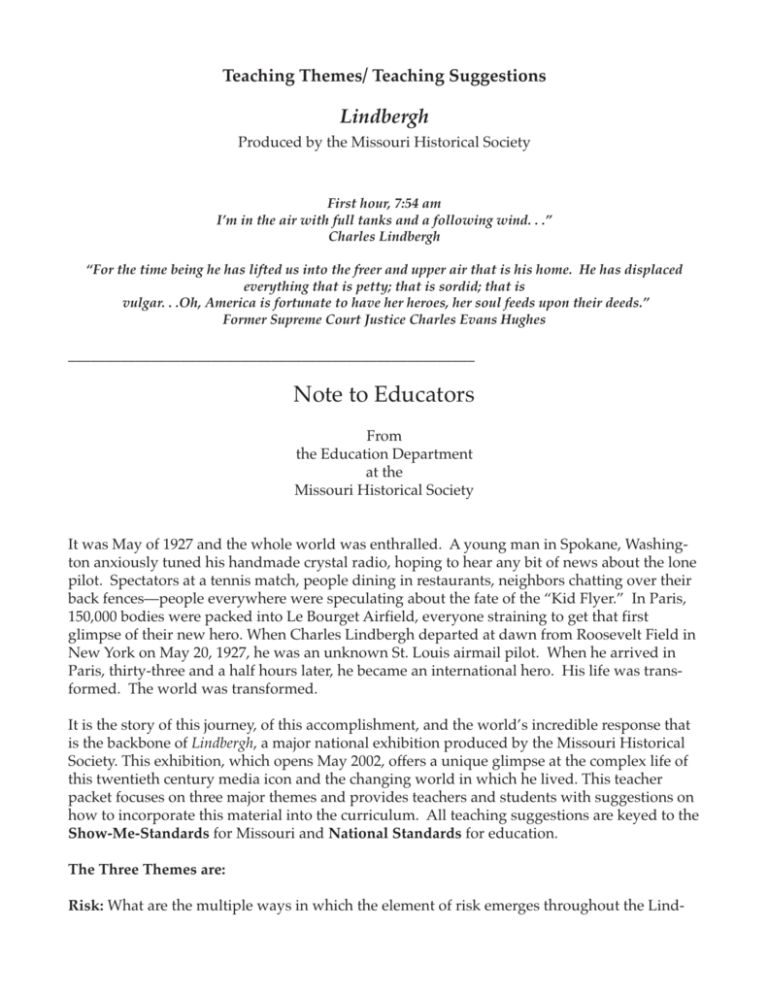
Teaching Themes/ Teaching Suggestions Lindbergh Produced by the Missouri Historical Society First hour, 7:54 am I’m in the air with full tanks and a following wind. . .” Charles Lindbergh “For the time being he has lifted us into the freer and upper air that is his home. He has displaced everything that is petty; that is sordid; that is vulgar. . .Oh, America is fortunate to have her heroes, her soul feeds upon their deeds.” Former Supreme Court Justice Charles Evans Hughes ______________________________________________________ Note to Educators From the Education Department at the Missouri Historical Society It was May of 1927 and the whole world was enthralled. A young man in Spokane, Washington anxiously tuned his handmade crystal radio, hoping to hear any bit of news about the lone pilot. Spectators at a tennis match, people dining in restaurants, neighbors chatting over their back fences—people everywhere were speculating about the fate of the “Kid Flyer.” In Paris, 150,000 bodies were packed into Le Bourget Airfield, everyone straining to get that first glimpse of their new hero. When Charles Lindbergh departed at dawn from Roosevelt Field in New York on May 20, 1927, he was an unknown St. Louis airmail pilot. When he arrived in Paris, thirty-three and a half hours later, he became an international hero. His life was transformed. The world was transformed. It is the story of this journey, of this accomplishment, and the world’s incredible response that is the backbone of Lindbergh, a major national exhibition produced by the Missouri Historical Society. This exhibition, which opens May 2002, offers a unique glimpse at the complex life of this twentieth century media icon and the changing world in which he lived. This teacher packet focuses on three major themes and provides teachers and students with suggestions on how to incorporate this material into the curriculum. All teaching suggestions are keyed to the Show-Me-Standards for Missouri and National Standards for education. The Three Themes are: Risk: What are the multiple ways in which the element of risk emerges throughout the Lind- bergh story? Heroism: How did the world respond to the 1927 flight? What expectations of people and characteristics of society at that time provided the context for seeing Lindbergh as a hero? What role did Lindbergh’s acceptance of Nazi Germany’s medal and his views on isolationism have on diminishing his status as a hero? Tension and Balance: What impact did Lindbergh’s flight and the advances in aviation have on the environment? How did Lindbergh seek to achieve a balance between technology and nature? ______________________________________________________ Teaching Theme Risk Risk \risk\ n (ca. 1661) 1. the possibility of loss or injury 2. a dangerous element or factor 3. an insurance hazard from a specified cause or source. —Webster’s Ninth New Collegiate Dictionary. Overview: The 1927 transatlantic flight was all about RISK, risk to the young man who would try to plan a flight that no one else had successfully accomplished and risk to the nine St. Louisans who put forth financial support to back an unknown air mail pilot. The story of risk in Lindbergh provides us with a teaching opportunity to think about how we assess risk in our own lives. As children, our risk factors might seem simple: Should I risk doing the right thing even if it is deemed unpopular? As teenagers, things become more complicated: Should I risk smoking or drinking to fit in with peers? As adults, the stakes are often very high: Should I leave a highpaying job that leaves me unsatisfied for a lower paying job doing something I love? Look at the ways in which the element of risk emerges in the Lindbergh story. Place yourself in Lindbergh’s shoes as you analyze his thought process while planning for the flight. Then imagine that you are a backer, faced with a decision to fund this flight or risk rejecting what might be a historic feat. Utilize the teaching suggestion to connect this story to your own life, as you think about the many risks that you face every day. The Risk: Weight vs. Fuel “Safety at the start of my flight means holding down weight for the take-off. Safety during my flight requires plenty of emergency equipment. Safety at the end of my flight demands an ample reserve of fuel. It’s impossible to increase safety at one point without detracting from it at another. I must weigh all elements in my mind and attempt to strike some balance.”— Charles Lindbergh On a routine airmail flight, Lindbergh wondered what it would be like if fuel didn’t weigh so much, if he could have enough gasoline loaded in his plane to fly for days. He thought about the Orteig Prize being offered to the first person to fly non-stop across the Atlantic. Was it possible? In an effort to win this prize, famed aviator Renee Fonck had loaded down his bi- plane with unnecessary items—resulting in an explosion and the loss of two crewmembers. Lindbergh wondered: How could a pilot offset the risk of overloading the plane and still have enough fuel to keep the engine running for almost two days? What would a pilot need to take along? What could a pilot risk leaving behind in order to conserve weight? The more he pondered these questions the more Lindbergh became convinced that they key to successfully handling such a risky flight was striking a delicate balance between weight and fuel. Each one of the items that Lindbergh decided to take, or leave behind, represented a calculated decision to achieve a balance between the risk of not having an item and the risk of extra weight. Take a moment to look at this list of items, taken on the transatlantic flight, and read the paragraph about why Charles Lindbergh made this decision. A Flashlight —There were no lights in the Spirit, so Lindbergh took a flashlight to see his maps and instrument panels. He left behind heavier navigational equipment. A Knife —Lindbergh decided to take a large knife. He may have needed it to cut fabric from the plane should it go down in the Atlantic. He left behind a parachute. (It would have added 20 lbs!) A Mercator Chart (Map) —Lindbergh needed a navigational chart of the globe, which measured out the entire flight. He trimmed the edges of the paper to conserve weight. Flight Suit —Lindbergh took with him a waterproof suit with a wool lining, which weighed nine pounds. This would keep Lindbergh warm if he were forced to survive in the cold Atlantic waters. The Risk: Financial Loss vs. A Potential Role in a Historic Event The risk associated with the Lindbergh story was not Lindbergh’s alone. There were nine St. Louis businessmen who were faced with a decision: whether to risk their financial security and take a chance on this venture or miss out on being an integral part of what might be one of the most exciting accomplishments in history. Step into the shoes of these nine men and weigh the pros and cons of putting up your own money to fund such a trip. Would you have been persuaded? Would you have taken a chance on this unknown airmail pilot? Prior to the flight, Charles Lindbergh wrote this persuasive paragraph stating the benefits of a transatlantic flight supported by St. Louis. Read and think about the arguments that Lindbergh used to persuade his backers: “St. Louis is ideally situated to become an aviation city. We have one of the finest commercial airports in the United States, and we will undoubtedly become a hub of the national airways of the future. Some day airliners on their way from New Orleans to Chicago, and from Los Angeles to New York, will be landing on our airport.” —Charles Lindbergh Contrast Charles Lindbergh’s persuasive paragraph with this bit of history: Charles Lindbergh was not able to convince everyone to fund his flight. Prior to the flight Harry Hall Knight, one of Lindbergh’s backers, received a letter from the St. Louis Post-Dispatch. It explains that the newspaper did not want any connection to such a risky flight. If you were a potential backer, would this development make you think twice about funding Lindbergh? If a reputable newspaper felt it was too risky, should you? TEACHING SUGGESTIONS: Imagine that you are about to embark on a solo adventure much like Lindbergh. Your trip will take you to some of the most remote areas in Alaska. Like Lindbergh, you will need to meticulously prepare if you are to survive the harsh climate and unpredictable conditions. First, gather as much information as possible about the area of Alaska in which you will be traveling. Next, map out your trip, considering what types of transportation you will need. Then, using the information that you gathered during your initial research, predict what types of items you may want to take. Keep in mind that you will need to carry these items all by yourself. Try to fit all of your necessary items in a box that you can carry comfortably. Present your research to your class. (SMS, 1, 3) (NL-ENG.K-12. 4-9) (NSS-G.K-12. 1, 2, 6) Working in teams, pretend that you are about to be a part of the first manned space shuttle to travel to a distant planet. Like Lindbergh’s flight, this trip will need to be financed by backers. In addition, the shuttle will have to be built to certain specifications to ensure survival. Each team member should take on a different role in this story of this historic space flight. Each role will carry with it a different assignment: (SMS, 1-2) (NL-ENG.K-12.3-8) The Astronaut (s): Your job is to think through this entire trip. Imagine why you might want to travel to this distant planet. What would success mean for your country and for the world? Write a persuasive letter to people who might finance your trip. Make up lists of equipment that you might need. Think through how you might want your spacecraft to be built. Research other successful and unsuccessful space flights. What should be done the same? What should be done differently? The Backer (s): Your job is to decide whether or not to fund this space shuttle trip. Listen to the arguments made by the astronaut. Research other space flights along with the qualifications of the astronaut. Write out a list of pros and cons about financing this trip. Think about how you might benefit from supporting this trip. Would you become famous or wealthy? Think about what you might stand to lose if you support this trip. Might you waste you money or ruin your reputation? Write out the answers to these questions. Present your final decision to the astronaut. The Media: Your job is to report on this potential space shuttle trip. Interview both the astronaut and the potential backer. Decide how you want to portray the people involved with this story. Write a newspaper article or videotape a news broadcast about this trip. Research other reports of famous expeditions to help you write your report. Using Lindbergh and the backers as an example, have your students brainstorm the different types of risks they face and the difficult choices that they and their peers have to make. Pick a couple of examples and lead your students in an exercise: naming the choices they face; weighing the risk factors involved; making a list of pros and cons; and finally making an educated decision as a group. To get started, use smoking or drinking as examples. Contact your local D.A.R.E. program for an extended curriculum. (SMS, 3) (NL-ENG.K-12.3-7) ______________________________________________________ Teaching Theme The Lindbergh Story and Heroism Hero \hi(e)r-o\ n (14c): 1. a. A mythological or legendary figure b. a person admired for his/ her achievements and noble qualities c. one who shows great courage. —Webster’s Ninth New Collegiate Dictionary Heroism \her-o-wiz-em\ n (1717): 1. heroic conduct esp. as exhibited in fulfilling a high purpose or attaining a noble end 2. the qualities of a hero. —Webster’s Ninth New Collegiate Dictionary Overview: “After the flight, Charles Lindbergh. . .literally became all things to all [people.]”—Paul Gerber “He served as a blank screen onto which each person projected his own best images of man. . .So long as Lindbergh remained neutral on controversial topics, that remained true.”—Scott Berg One of the most compelling aspects of Charles Lindbergh’s story is the idea that this relatively unknown airmail pilot became one of the world’s most adored people, quite literally overnight. Such an amazing feat, in a moment in history when there was great excitement about technology, cast Lindbergh into the mythological role of “hero.” He was showered with gifts and letters from nearly every country around the world. Amateurs and professionals rushed to pen songs and poems hailing him “Columbus of the Air” and “America’s Son.” The “Lindy Hop” became the dance craze of the young generation and schoolchildren were taught to extol his personality traits. Lindbergh’s unassuming manner and wholesome image attracted all types of people to him; yet, his heroic image was tarnished during the years leading up to World War II. The same people who once adored the young aviator now called Lindbergh anti-Semitic, unpatriotic, and at worst a traitor. By examining the complex notion of heroism as it emerges throughout the Lindbergh story, we have an opportunity to think through these important questions dealing with the role of heroes in society: How and why do people create heroes? What are the qualities common in heroes? Are heroes and celebrities the same, or are there differences? What happens when our heroes don’t live up to our images of them? TEACHING SUGGESTIONS: According to Joseph Campbell, author of The Hero with a Thousand Faces, heroism is an archetypal construct found in nearly every type of culture and society around the world. The story of Charles Lindbergh and his role as a 20th century hero provides us with an opportunity to think about the role that heroes have played in society and in our own lives. Using the Internet and your local library, research hero stories throughout history. Compare Lindbergh and his role as a hero to heroes throughout history. Begin by gathering background information, using Joseph Campbell’s book or by ordering the PBS Adult Learning Service curriculum “The Hero’s Journey.” Think about the concept of celebrity as it relates to the concept of heroism. Using the same brainstorming exercise, list some people who fall into the hero category. Then, list some people who fall into the celebrity category. Is there anyone on this list that could be both a hero and a celebrity? If so, what qualities do they exhibit that help them fill both roles? In what way is Lindbergh similar to these people? In what way is he different? Research the rise of celebrity in the 20th century. Read some newspapers from 1927, and think about how reporters wrote about heroes and celebrities. Did these reporters use the qualities, that appear on your list, in the description of these heroes and celebrities? Read some Greek mythology in order to better understand how that culture defined heroism. Use the website: http://www.mcli.dist.maricopa.edu/smc/journey. This website, the Maricopa Center for Learning and Instruction, allows students to explore the classical myth structure of stories and helps students create their own myths. Compare and contrast Greek myths with hero myths of the American West. Familiarize yourself with cowboy poems or ballads memorializing people such as Davy Crockett, etc. Through a brainstorming exercise, generate a list of the qualities common among heroes of these stories. Here is a list of ideas for the design of your projects: Create a collage, a painting, or a drawing illustrating one of the heroes in these stories. Make sure to capture the qualities that make this person a hero. Write a song, story, or poem that mythologizes someone who you consider a hero. Create a gift that you might present to that person. Write a script that dramatizes Lindbergh’s role as both a hero and as a fallen hero. Find some other historical figures, like Lindbergh, who achieved hero status and then fell from that pedestal. Write a script that dramatizes this aspect of their lives. Write a research paper or create a powerpoint presentation analyzing the similarities and differences between a hero and a celebrity. Construct the front page of a newspaper or videotape a radio broadcast about the heroes and celebrities you have studied. Create a comic book or flip book showing Lindbergh or your favorite hero in action. ______________________________________________________ Teaching Theme The Lindbergh Story and Tension and Balance Tension \ten-chen\ n (1533): an inner striving, unrest, or imbalance often with physiological indication of emotion. —Webster’s Ninth New Collegiate Dictionary. Balance \bal-en(t)s\ n (1588): to bring into harmony or proportion. —Webster’s Ninth New Collegiate Dictionary. Overview: “Born at the beginning of the exponentially advancing twentieth century A.D. I have experienced more change in the environment of man than took place during all previous centuries since civilization began—as though the impact of thousands of years had been upon a single individual.”—Charles Lindbergh Lindbergh was born into an age of rapidly advancing technology. He was also born into an age of tension, where new technology, which made life easier for so many, often put a strain on the natural world. Whereas aviation had revolutionized travel, allowing people and ideas to flow more freely in space and time it also brought civilization into areas that had once been relatively untouched. With an influx of population into wilderness, the natural world could be placed in jeopardy. In addition, his experience in World War II taught Lindbergh that technology could be used to end life as readily as it is used to enhance life. Toward the end of his life, Lindbergh became increasingly alarmed by the tension that existed between civilization and rapidly advancing scientific and technological developments. Lindbergh worked to achieve balance. He stated that “modern civilization places emphasis on increasing knowledge and the application of technology to man’s way of life. The human future depends on our ability to combine knowledge of science with the wisdom of the wilderness.” For Lindbergh, this meant making clear connections between modes of technology and their implications on the environment and human civilization. This type of thinking led Lindbergh into work that brought him in constant contact with the living world. He fought to save endangered species and researched technologies that would help rather than hurt humankind. The story of tension and balance within the Lindbergh story allows us to think through these important questions: What are the tensions evident in our society? How do we strive to achieve a balance between technology, science, and our environment? How do we protect life, which can be fragile in the face of advancing civilization? TEACHING SUGGESTIONS: Lindbergh lobbied governments for the protection of a variety of endangered species. His work, in part, contributed to the development of the Endangered Species Act of 1973. Research and write about the history of this act. Use the endangered species web site: http:// www.eelink.net/EndSpp or the World Wildlife Fund web site: http://www.wwfus.org as a guide. (SMS, 1) (NL-ENG.K-12. 2-8) (NSS-G.K-12.5) Technology and science advance every day; ethical questions are often formed when these advances outpace theory and law. Using your local newspaper and the Internet, find examples of controversial technological or scientific advances. Some examples are cloning, genetically engineered crops, stemcell research, etc. Pick a stance on either side of the issue and have a debate, either one-on-one or in teams. (SMS, 1-2) (NL-ENG.K-12. 1-8) (NT.K-12.2) Lindbergh observed that the advances in the twentieth century were astounding! One need only to look at the aviation industry to see how quickly things changed in 100 years. Pick one technological or scientific innovation that we take for granted today. Create a time line or a collage illustrating how this innovation developed throughout the twentieth century. (SMS, 2) (NL-ENG.K-12. 1-8) (NSS-WH.5-12. 8-9) Read Lindbergh’s autobiography of his early childhood years, Boyhood on the Upper Mississippi. Pay close attention to the differences between Lindbergh’s childhood and your own, especially in terms of technology. Script out a creative dialogue between a child in the twentyfirst century and a child living in 1927. Have this dialogue reflect the differences in everyday lifestyles. (SMS, 2) (NL-ENG.K-12. 1-8) (NA-T.5-8.1) (NA-T.9-12.1) Lindbergh spent much time visiting and working with less technologically advanced cultures around the world. He found much beauty and sophistication in the way that these men and women lived. Research a particular culture that relies less heavily on technology. Think about the values that influence this group of people. Create a banner or a painting that might symbolically represent these values and the lifestyle of this culture. Use the National Geographic web site: http://www.nationalgeographic.com as a guide. (SMS, 1-2) (NL-ENG.K-12. 8-10) (NSS-G.K-12. 4-5) ______________________________________________________ Bibliography Works by the Lindbergh Family Lindbergh, Anne Morrow. Bailey’s Window Lindbergh, Anne Morrow. Bring Me a Unicorn: Diaries and Letters of Anne Morrow Lindbergh, 1922-1928. Harcourt, 1972. Lindbergh, Anne Morrow. Dearly Beloved: A Theme and Variations. New York: Harcourt, Brace & World, 1962. Lindbergh, Anne Morrow. Earth Shine. Lindbergh, Anne Morrow. The Flower and the Nettle: Diaries and Letters, 1936-1939. New York: Harcourt, 1976. Lindbergh, Anne Morrow. Gift From the Sea. New York: Pantheon. Lindbergh, Anne Morrow. Hour of Gold: Diaries and Letters of Anne Morrow Lindbergh, 19291932. New York: Harcourt Brace Jovanovich, 1973. Lindbergh, Anne Morrow. The Hunky-Dory Dairy. Lindbergh, Anne Morrow. Locked Rooms and Open Doors. Harcourt, 1974. Lindbergh, Anne Morrow. Next Time, Take Care. Lindbergh, Anne Morrow. Nick of Time. Boston: Little, Brown, 1994. Lindbergh, Anne Morrow. Nobody’s Orphan. Lindbergh, Anne Morrow. North to the Orient. Harcourt, 1935. Lindbergh, Anne Morrow. Osprey Island. Lindbergh, Anne Morrow. The People of Pineapple Place. Lindbergh, Anne Morrow. The Shadow on the Dial. Lindbergh, Anne Morrow. Three Lives to Live: A Novel. Lindbergh, Anne Morrow. Tidy Lady. Lindbergh, Anne Morrow. Travel Far, Pay No Fare Lindbergh, Anne Morrow. The Unicorn. Lindbergh, Anne Morrow. War Within and Without: Diaries and Letters of Anne Morrow Lindbergh, 1939-1944. New York: Harcourt, 1980. Lindbergh, Anne Morrow. The Worry Week. Lindbergh, Charles Augustus. Autobiography of Values. New York: Harcourt Brace, 1978. Lindbergh, Charles Augustus and O’Hara, Megan. The Boyhood Diary of Charles A. Lindbergh, 1913-1916: Early Adventures of the Famous Aviator (Diaries, Letters, Memoirs). Mankato, Minnesota: Blue Earth Books, 2000. Lindbergh, Charles Augustus. Boyhood on the Upper Mississippi: A Reminiscent Letter. St. Paul: Minnesota Historical Society, 1972. Lindbergh, Charles Augustus and Collins, Michael. Carrying the Fire: An Astronaut’s Journeys, 1989. Lindbergh, Charles Augustus and Horrigan, Brian (Intro). Lindbergh Looks Back: A Boyhood Reminiscence. Lindbergh, Charles Augustus. Lindbergh on the Federal Reserve Economi. Lindbergh, Charles Augustus and Anne Morrow. Listen! The Wind. Harcourt, 1938. Lindbergh, Charles Augustus. Of Flight and Life. New York: Scribner, 1948. Lindbergh, Charles Augustus. The Spirit of St. Louis. New York: Scribner, 1953. Lindbergh, Charles Augustus. The Wartime Journals of Charles A. Lindbergh. New York: Harcourt Brace, 1970. Lindbergh, Charles Augustus. We. New York; London: Putnam Publishing Group, 1972. Lindbergh, Reeve. Nobody Owns the Sky: the Story of “brave Bessie” Coleman. Cambridge: Candlewick Press, 1996. Lindbergh, Reeve. No More Words: A Journal of My Mother, Anne Morrow Lindbergh. New York: Simon & Schuster, 2001. Lindbergh, Reeve. Under a Wing: A Memoir. New York: Simon & Schuster, 1998. Lindbergh, Reeve. View From the Air: Charles Lindbergh’s Earth and Sky. New York: Viking Press, 1992.
